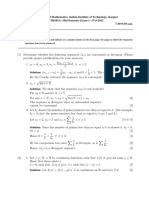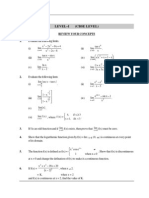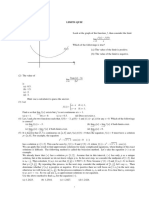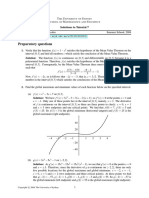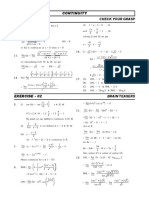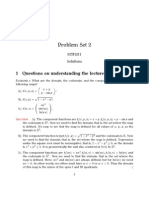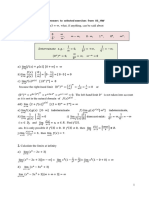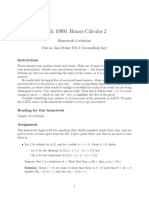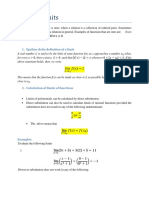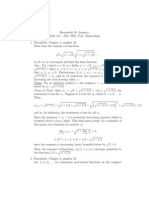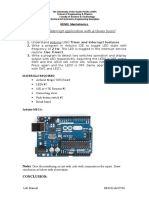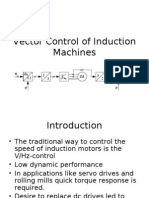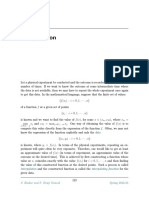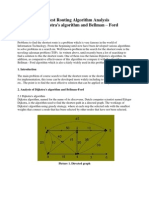MA111 In-Form Test 1 Solution
1. Find the following limits:
2+x
(a) lim
x4 (x 2)(x 4)
(b) lim
y2 + 2
3y 6
(c) lim | tan1 z|
z
SOLUTION
(a)
lim (2 + x) = 6,
x4
lim (x 2) = 2,
x4
lim (x 4) = 0.
x4
However, (x 4) < 0 for all x < 4. Hence,
lim
x4
(b)
p
lim
(c)
2+x
= .
(x 2)(x 4)
p
y2 + 2
y2
|y|
y
1
= lim
= lim
= lim
= .
y 3y
y 3y
y 3y
3y 6
3
lim | tan1 z| = | lim tan1 z| = = .
z
z
2
2
�2. A piecewise function f can be di�erentiated at a point a if f is continuous at a, and if
limxa f 0 (x) = limxa+ f 0 (x) = L, with f 0 (a) = L.
Consider the function
2
x /2 , x 0
x2 , x > 0
f (x) =
(a) Give a rough sketch of f .
2
1
-2
-1
-1
-2
-3
-4
(b) Show that f is continuous at x = 0.
SOLUTION. We have to show that lim f (x) = f (0). Now,
x0
lim f (x) = lim
x0
x0
x2
=0
2
and lim+ f (x) = lim+ (x2 ) = 0
x0
x0
Thus, x0
lim f (x) = 0. To �nd f (0), we use the function f (x) = x2 /2. This gives
f (0) = 0. Hence, since lim f (x) = f (0), f is continuous at x = 0.
x0
(c) Show that f is di�erentiable at x = 0.
SOLUTION
The boundary point is x = 0. To see if f is di�erentiable x = 0, we �rst check that
it is continuous at x = 0. In part (b), we have shown this.
Next, ignoring x = 0 for the time being, we have
f (x) =
Thus,
lim f 0 (x) = lim x = 0
x0
and
x, x < 0
2x , x > 0
x0
lim f 0 (x) = lim+ (2x) = 0
x0+
x0
Hence, it follows that
f 0 (0) = 0
Thus, f is di�erentiable at x = 0.
2
�(d) Find f 0 (x).
SOLUTION
0
f (x) =
x, x 0
2x , x > 0
(1)
(e) Using results in (d) above, do the following:
i. Determine the largest interval on which f is increasing;
Solution
Equation (1) shows that f 0 (x) < 0 for all x (, 0) (0, +). Hence, there
is no interval on which f is increasing.
ii. Determine the largest interval on which f is decreasing;
Solution
I = (, 0) (0, +)
iii. Determine if f has a turning point on (, +). Give your reason.
Solution
f 0 (x) = 0
at x = 0. Hence, there is a turning point at x = 0.
3. (a) Consider the function f (x) = x2/3 , with a = 1 and b = 8. Show that there is no
point c (a, b) such that
f 0 (c) =
f (b) f (a)
.
ba
Solution
Since
f 0 (x) =
we have
f 0 (c) =
Solving for c, we have
2
3x1/3
f (8) f (1)
2
41
1
=
=
=
1/3
3c
8 (1)
8+1
3
c = 8 6 (1, 8)
(b) Does the result above violate the Mean-Value Theorem? Explain.
Solution
The result in (a) does not violate the Mean-Value Theorem because
f 0 (x) =
2
3x1/3
is not de�ned at x = 0 and hence f is not di�erentiable on (1, 8).
�4. Consider the function f (x) = x + ln x on the interval (0, e], e 2.71828.
(a) Apply the Intermediate Value Theorem to show that f (x) = 0 has at least one root
in (0, e].
Solution
The function is continuous on (0, e), since for every c (0, e), we have that xc
lim f (x) =
f (c). Morever, it is continuous from the left at e, since lim f (x) = f (e). Thus, f
xe
is continuous on (0, e].
Now,
lim f (x) = < 0,
x0+
and
f (e) = ln e = 1 > 0.
Thus, by the IVT, f (x) = 0 has a root in (0, e].
(b) Apply Rolle's Theorem to show that the root whose existence is guaranteed in (a)
above is in fact the only root in (0, e].
Solution
We have shown that f is continuous on (0, e]. Moreover, f is di�erentiable on (0, e)
1
1
since f 0 (x) = 1 + and f 0 (c) = 1 + exists for all c (0, e).
x
c
Now assume that f (x) = 0 has two roots in (0, e]. Then by Rolle's Theorem, there
is a c (0, e) such that
f 0 (c) = 1 +
1
= 0.
c
Solving for c, we have c = 1. But this is outside (0, e). Thus, f (x) = 0 cannot
have two roots in (0, e].
(c) Choosing x = 1.0 as the �rst approximation to the root in (0, e], use Newton's
Method twice to �nd better approximations to the root. (Use 6 decimal places in
your calculations.)
SOLUTION
f (x1 )
1 + ln 1
1
1
=1
= 1 = = 0.5,
0
f (x1 )
1 + 1/1
2
2
0.5 + ln 0.5
f (x2 )
= 0.5
0.564382.
= x2 0
f (x2 )
1 + 1/0.5
x2 = x1
x3
(d) Without using the graph of f or trying to derive f 1 , the inverse of f , show that
f 1 exists.
SOLUTION
Since f 0 (x) = 1 + 1/x > 0 for all x (0, e), and limxe f 0 (x) = 1 + 1/e > 0, f is
increasing on (0, e]; hence it is one-to-one, and therefore has an inverse.
4
�(e) Give the domain and range of f 1 .
SOLUTION
Range f 1 = Domain f = (0, e],
Domain f 1 = Range f = (, e + ln e] = (, 1 + e].
(f) Sketch f and f 1 in the same xy -plane, showing all the intercepts.
SOLUTION
4
y = f HxL
3
2
1
y = f -1HxL
-2
-1
-2
-3
(g) Find a formula for the derivative of f 1 and give the largest interval on which the
derivative exists.
SOLUTION
Let y = f 1 (x). Then x = f (y) = y + ln y. Hence,
dx
1
y+1
=1+ =
,
dy
y
y
Thus,
dy
y
= (f 1 )0 (x) =
.
dx
1+y
which is de�ned for every y (0, e].





















